51ST ANNUAL CONFERENCE, Kathmandu, Nepal, 12-16 March 2012WP No. 85Study Continuous Climb OperationsPresented by TOC |
Summary
Recent experience has proven the potential of new departure procedures known as Continuous Climb Operations (CCO). CCOs enable aircraft to climb in the most economical fashion, saving on emissions and costs but also providing a potential improvement in safety.
This paper examines the global status of Continuous Climb procedures and recommends policy to guide further development and implementation.
Introduction
1.1 Traditional air traffic control manages departures incrementally, providing clearance to a series of higher altitudes as determined tactically by the controller based on traffic, route, terrain and airspace. A typical trajectory is shown in the diagram in blue with a series of level-offs.
1.2 The smooth green curve shown represents the ideal trajectory an aircraft might follow in the absence of any ATC issues, such as during a midnight shift or departing from a remote aerodrome. In this profile, the aircraft’s own priorities are the sole determinants of the trajectory. The aircraft is flown according to the pilot’s needs, whether for smooth air, fuel efficiency, speed, noise reduction or some other concern. Such trajectories are considered “continuous” because there is typically no level-off.
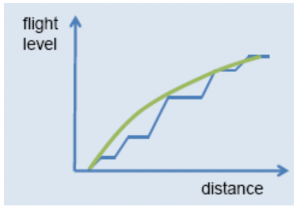
1.3 Achieving continuous climbs and descents – trajectories driven by the needs of the aircraft – is a goal of future ATC.
“The transition to a performance-based National Airspace System (NAS) is envisioned to support improvements in the continuity of vertical operations resulting in significant benefits to aircraft operators.”
1.4 Towards that end, a new class of procedures has been created called Continuous Climb Operations (CCOs). These procedures are intended to enable aircraft to fly their ideal trajectory as much as possible within the limits of the ATC system.
1.5 Such procedures are meant to reduce fuel burn, emissions and costs but are also considered to have other benefits.
“Improving the continuity of vertical operations is expected (1) to relieve ATC from routinely issuing climb and descent clearances often involving multiple intermediate altitudes and (2) to result in more efficient aircraft climb and descent operations with reduced fuel burn and lower environmental impact.”
Discussion
2.1 Continuous climb refers to enabling departing aircraft to climb via the most economical trajectory rather than the incremental profile resulting from traditional air traffic control procedures.
2.2 Source of Benefits
2.2.1 Savings are realized by continuous climb procedures because, in plain terms, aircraft get better mileage at altitude. Excluding wind effects, the aircraft at cruise covers more ground for the same amount of fuel. The longer the aircraft takes to climb, the more time it spends burning more fuel at lower altitude. The assignment of speeds can also affect the equation, particularly if the aircraft is forced to level off and slow down.
2.2.2 More efficient operation of aircraft means lower fuel costs and reduced emissions.
2.2.3 Savings are also realized because the aircraft total flight time is reduced. Since aircraft fly faster at altitude, the aircraft that gets to cruise first will get to the destination first as well. This will save crew and maintenance costs for the operator.
2.2.4 Noise savings are realized if continuous climb procedures are applied in the terminal environment, since faster climbing aircraft make less noise.
2.3 Quantification of Benefits – MITRE Study 2008
2.3.1 In 2008, FAA tasked the MITRE Corp. to assess the value of the potential benefits, in fuel savings and emissions reductions. The study viewed any time spent in level flight between cruise and the runway as potential for savings. Since level flight segments during departure or arrival are inefficient, the study sought to quantify the amount of time that aircraft currently spend in level flight segments during departure and arrival.
2.3.2 The study gathered radar data on 35 major airports in the US for one day, 5 October 2006. Conditions that day were mostly VFR. This data included roughly 37,000 flight tracks. They were carefully assessed and filtered. Only jet traffic was included. Flights that could not be positively identified as climbing to or descending from altitudes above 10,000 feet were excluded. Because the source of the data was terminal radar, only level-off segments up to about 20,000 feet AGL were included. These aircraft may have leveled off in the en route environment as well so the results can be considered conservative.
2.3.3 The goal of the approach was to count all of the time spent by the 37,000 flights in level flight between the runway and cruising altitudes. MITRE developed algorithms to identify each series of radar returns that indicated the flight had leveled off. Each level-off segment was then compiled into a database. Analytics were then applied to all of these flight segments to determine total amounts of time spent by these 37,000 aircraft in level flight. These totals were then broken down by airport and also by air traffic facility, or Tracon, many of which serve multiple airports. The results are shown below. The term “OEP” refers to the 35 major airports. The facilities in (b) are listed in the Appendix.
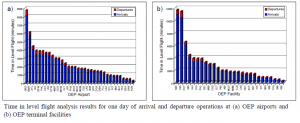
2.3.4 The results show that a high percentage of potential savings come from just a few facilities, mainly New York, Chicago, Atlanta, Houston, Dallas and Philadelphia.
2.3.5 The results show that departures do not represent a large source of potential savings. Apparently, departure procedures in the US are already fairly efficient and do not typically include long level flight segments, even at the largest airports.
2.3.6 The results were also shown in geographic format as below. The dramatic potential benefits of improved descent operations is made even more apparent, as is the imbalance in potential benefits between Eastern and Western airports.
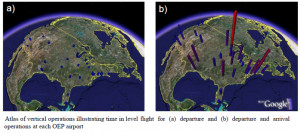
2.3.7 The report doesn’t stop there but delivers projected savings in USD as shown below. These figures include both descent and climb operations, but the climb operations represent about 10% of the totals. Note that the time benefit is slightly larger than the fuel benefit, meaning that savings in crew and maintenance costs dues to shorter flight times are more significant than savings in fuel, although fuel prices could alter that equation.
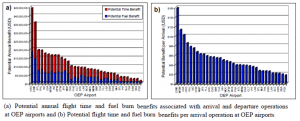
2.3.8 The report estimated the overall potential benefit of continuous climb and departure operations at the 35 airports to be 380 million USD per year. Of this figure, 90% were found to be associated with improvements of arrival operations, and only 10% in the improvement of departure operations.
2.3.9 The environmental benefits of both continuous climb and departure were evaluated to be a reduction of 850,000 metric tons of CO2 and 216 metric tons of SOx.
2.3.10 The report did not attempt to quantify or address improvements in noise pollution. However, it can be assumed that improvements in the descent phase would represent more significant noise reduction than improvements in the climb phase. This is because, at least in the US, descending aircraft spend much more time in level flight than do departures.
2.4 NASA DFW Analysis 2010
2.4.1 NASA studied the potential benefits of implementing continuous climb procedures at Dallas/Ft. Worth (DFW) in 2010. The study observes that the implementation of continuous descent operations in some cases makes continuous climb procedures possible. By keeping the arrivals higher, departures no longer need to level off to remain under the arrivals at DFW. From the study:
“Continuous descent trajectories at DFW present an opportunity for lifting restrictions on departure climbs.”
2.4.2 The study showed graphically the advantage of continuous climb as shown here. At cruise, the aircraft covers more ground faster and more efficiently than at 10,000 feet.
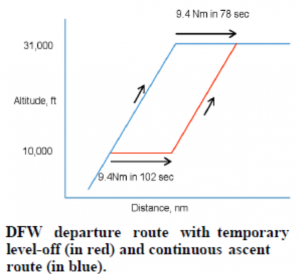
2.4.3 The study reviewed a specific procedure in which departure aircraft level off at 10,000 feet while waiting to clear arrival traffic. Data was taken over a nine day period, consisting of over 3800 flights.
2.4.4 Like the MITRE study, the NASA study identified and compiled level flight segments. It found that 20% of the flights studied leveled off at 10,000 feet, and of these, the average aircraft flew in level flight for 1.7 minutes. The fuel burn estimates were calculated using Eurocontrol’s BADA simulation tool. Were these aircraft able to fly a continuous climb, the study calculated they would save 7 gallons of fuel out of approximately 450 gallons needed to climb to cruising altitude.
2.4.5 The results were in line with the predictions from the MITRE study. The savings of 7 gallons out of 450 (1.67%) is one-tenth of the typical savings of 50 gallons out of 300 (16.7%) for continuous descent operations noted in IFATCA 2011 Amman WP 95.
2.4.6 Unlike the MITRE study, the NASA study did not try to evaluate a savings associated with crew and maintenance costs based on a shorter overall flight time. It also did not review noise issues.
2.5 AIRE Testing 2009
2.5.1 Over one thousand flight trials conducted in 2009 demonstrated that 135,000 tons of CO2 can be saved each year on Air France flights between North America and cities in Europe including Madrid, Paris, Stockholm and others.
2.5.2 April 6, 2010 – Air France 690 flew a demonstration “green” flight from Paris to Miami. The aircraft received minimum taxi time, continuous climb, optimized speed and altitude in cruise, and continuous descent. The flight demonstrated a savings of 2-3 tons of fuel and an emissions reduction of 6-9 tons of CO2. Noise levels at departure and arrival airports were both reduced by up to 7 dB. A second flight, American 63, took place on April 7 with similar results. Continuous climb was seen to be an important aspect of developing more environmentally-friendly procedures.
2.6 ICAO
2.6.1 Performance Based Navigation Task Force (PBN/TF/7) met in Bangkok, Thailand, 1-3 September 2010. The following decision was made:
2.1.3.5 Continuous Climb Operations. Any work on this element has been suspended, pending resources.
2.6.2 ICAO has completed a first draft of the Continuous Climb Manual and the Instrument Flight Procedures Panel expects to have a final draft ready in the spring.
2.7 IFATCA
2.7.1 IFATCA has no policy on continuous climb operations.
2.7.2 IFATCA does have policy on the ICAO Continuous Descent Manual (Doc 9931) approved in Amman 2011 and as follows:
| IFATCA defines Continuous Descent Operations as:
Continuous Descent Operations (CDO) are aircraft operating techniques facilitated by appropriate airspace and procedure design which meet all ATM requirements, allowing the execution of an optimized descent profile. IFATCA supports the development and implementation of Continuous Descent Operations provided that:
Doc 9931 should be amended as follows:
|
2.8 Impact on ATC
2.8.1 Using advanced RNAV procedures with vertical guidance, controllers gain the ability to issue very complex clearances, including multiple “above”, “below” and “at” restrictions. In the past, it was not practical to issue such clearances at one time because of both time constraints and the likelihood of error when communicating so much detail. But with the new procedures, such clearances can be issued very simply and quickly. This empowers the controller to make much more efficient and effective transmissions and save the effort needed to compose a clearance and monitor the readback. This is an important benefit to ATC that should not be overlooked.
2.8.2 Because the continuous climb clearance can contain multiple restrictions, it can in some cases replace the typical series of clearances issued by one or more controllers. For example, the standard clearance off the ground at a particular aerodrome may be to 5000’ because of a crossing traffic stream. Approaching 5000’, the pilot may then receive a clearance to 10,000’, and then when leaving 9000’ another clearance is issued to FL 180. In this traditional method, chunks of airspace are issued to the pilot in a series of clearances. But these clearances can potentially be replaced by a single clearance containing a vertical profile. This represents a big time savings as well as a reduced opportunity for transmission error. These benefits to ATC should also not be overlooked.
2.8.3 Complexity can also be bad for ATC. Complexity increases the opportunity for error. The core difference between the traditional “step-up” world of managing departures and the world of continuous climb is an increased level of spatial complexity. The aircraft flying an advanced RNAV procedure can maneuver within a complex volume of airspace. It becomes more difficult to project where the aircraft may be in the next few minutes, especially to controllers new to the concept. In the traditional world, the aircraft’s altitude is controlled directly – the pilot is told to climb or descend and how many feet, and restrictions are issued as needed. The airspace available to the pilot is usually obvious to the controller. In the new world, this is not always the case. It will depend on the clearance issued and how precisely the controller understands the vertical aspects of the procedure.
2.8.4 There will certainly be terminal environments in which there are both aircraft flying the vertical profile and others on the same procedure but no longer flying the vertical profile. This will present the controller with a dilemma in tracking which aircraft are on the profile. The ATC system could help the controller by enabling the modification of some aspect of the data block (color, etc.) to show which are on the vertical profile. The controller would have to update this data element in real time, and that represents workload.
2.8.5 Compliance is also an issue. It’s fairly straightforward to spot an aircraft that has violated a climb clearance above the assigned altitude, but it could be much more difficult to identify when an aircraft has violated an altitude required in the vertical profile of a SID. Automation could help; the software could monitor the target, identify when the aircraft has strayed from the profile and flag the aircraft to the controller by some change to the display. Note that the automation would have to somehow know that the aircraft had the clearance to fly the vertical profile, and therefore it would be even more important that the controller update this data element accurately in real time.
2.9 Procedure Design
2.9.1 Procedure design is an important aspect of mitigating adverse impacts to the controller and to the system.
2.9.2 From the pilot’s perspective, the ideal continuous climb procedure would provide departing aircraft with a direct path to join their routes and a wide altitude range to accommodate a variety of aircraft in a variety of wind and atmospheric conditions. To make this palatable to controllers, the airspace used by such a procedure could be sterilized so that no other routes pass through it. This method is known as “de-conflicting” airspace.
2.9.3 In totally de-conflicted airspace, all aircraft are on defined routes, some of which may have vertical guidance or limitations, and the aircraft are procedurally separated. While desirable from the standpoint of the safety, this is not practical because too much airspace is sterilized and unavailable for other purposes.
A departure procedure might only be used heavily during parts of the day. If the airspace used in the procedure is de-conflicted, it will be empty for the rest of the day. Forcing other aircraft to fly trajectories that completely avoid that airspace will certainly add many miles to their route, decreasing their efficiency and increasing their emissions. The sterilization of certain airspace will also cause a reduction in capacity since the controller has a smaller volume to work other traffic with. De-confliction is useful in the development of continuous vertical procedures but its use must be limited to enable efficient trajectories and efficient use of airspace.
2.9.4 The design of continuous climb procedures will need to provide enough airspace to enable users to benefit but retain enough airspace to enable controllers to maintain orderly and safe traffic flows. It must allow enough flexibility to give the controller options when handling a variety of traffic flows within the sector. To enhance safety, the design could also incorporate a configuration that provides some tolerance for both pilot and controller error.
2.9.5 The reality is that the airspace assigned to a continuous climb procedure will have to be carefully shaped and perhaps twisted through a slew of other channels of airspace like a snake slipping through an assortment of pipes. The result will not necessarily be ideal for pilots either in getting them on course quickly or in getting them an ideal climb every flight. But the result will be optimum to satisfy all users to the extent possible.
2.9.6 90% Rule
2.9.6.1 The IFATCA continuous descent policy noted in section 2.7.2 above refers to the “90% rule”. This rule encourages procedure designers to capture 90% of the typical trajectories within the new procedure. Attempting to capture more consumes too much airspace with decreasing gains for users.
2.9.6.2 It seems appropriate to consider this policy for continuous climb procedure design as well. The climb phase of flight is quite different from descent, however. While most aircraft must be designed for descent along the glide slope, there are less constraints in climb performance. Certainly every aircraft must be able to climb adequately to clear obstacles. Beyond that constraint, aircraft may be built for efficiency and have very low ideal climb rates, or they may be designed for performance and naturally climb very quickly. Of course, loading and atmospheric conditions will also have tremendous effect on an aircraft’s ideal climb trajectory.
2.9.6.3 There is a vast range of natural climb rates, from a lumbering, fully loaded A340 departing Los Angeles bound for Australia to an empty Lear 40 or military jet with afterburners. The trajectories followed by these aircraft are too diverse to try to capture 90% of them with a single procedure.
2.9.7 Fast lanes and slow lanes:
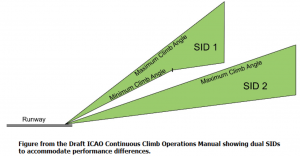
2.9.8 Because of this wide variation in climb rates, there may be cases where designers might offer separate procedures for slow and fast climbing aircraft. The situation might be akin to driving on the autobahn versus taking the back roads. Such a design would align well with the “best equipped, best served” policy. As shown in the figure above, ICAO has included this consideration in draft versions of the CCO Manual.
2.9.9 The ability to offer this option would be heavily dependent on local considerations and airspace. This could be a topic worthy of further study.
Conclusions
3.1 Continuous climb departures are considered by the industry as an important element of future ATM.
3.2 Continuous climb operations do not represent the same potential benefits as continuous descent because departure procedures are generally fairly efficient.
3.3 For the same route, continuous climb can provide the following benefits in comparison to step climbs:
- Reduced fuel burn
- Shorter flight times
- Reduced emissions
- Reduced noise
- Reduced number of ATC clearances
3.4 Generally, there will be a tradeoff between optimizing continuous climb operations and optimizing continuous descent operations. However, in some cases continuous climb operations can enable the implementation of continuous descent operations.
3.5 Continuous climb operations can provide controllers with an important advantage. They can be used to issue complex, multi-restriction clearances easily and quickly.
3.6 There are potential problems with the use of continuous climb:
- Complexity of procedures generally increases risk.
- Compliance with the vertical profile of a CCO is more difficult to monitor.
- Distinguishing which aircraft have been cleared to fly the vertical profile or not could be difficult.
3.7 Effective design of continuous climb procedures provides some level of de-confliction with other traffic flows.
3.8 The “90% Rule” recommended for use in design of continuous descent procedures is not appropriate for continuous climb because of the wide range of climb performance.
3.9 IFATCA policy on continuous descent operations is also relevant on continuous climb operations.
Recommendations
It is recommended that;
4.1 IFATCA policy is:
IFATCA defines Continuous Climb Operations as:
Continuous Climb Operations (CCO) are aircraft operating techniques facilitated by appropriate airspace and procedure design which meet all ATM requirements, allowing the execution of an optimized climb profile.
And is included in the IFATCA Technical and Professional Manual.
4.2 IFATCA policy is:
IFATCA supports the development and implementation of Continuous Descent Operations and Continuous Climb Operations provided that:
- Controllers are involved in the design.
- Airspace is suited to the design.
- The design meets the desired ATM capacity.
- Tactical interventions are always possible.
- Flight predictability is increased for both pilots and controllers.
- Controller workload is not increased beyond an acceptable level.
- It increases the overall performance of the ATM system without reducing safety.
And is included in the IFATCA Technical and Professional Manual.
4.3 IFATCA Policy:
IFATCA supports the development and implementation of Continuous Descent Operations provided that:
- Controllers are involved in the design.
- Airspace is suited to the design.
- The design meets the desired ATM capacity.
- Tactical ATC interventions are allowed.
- Flight predictability is increased for both pilots and controllers.
- Controller workload is not increased beyond an acceptable level.
Is deleted.
References
Benefit Potential of Continuous Climb and Descent Operations, Paul Melby and Ralf H. Mayer (MITRE Corp), International Council of the Aeronautical Sciences, Anchorage, Alaska, 14-19 September 2008.
A Terminal Area Analysis of Continuous Ascent Departure Fuel Use at Dallas/Fort Worth International Airport, Keenan Roach and John E. Robinson III (NASA Ames Research Center, AIAA’s 10th Annual Aviation Technology, Integration and Operations Conference, Fort Worth, Texas, 13-15 September 2010.
Atlantic Interoperability Initiative to Reduce Emissions – AIRE, Celia Rodrigues (SESAR Environment Officer), ICAO Colloquium on Aviation and Climate Change, Montreal, Canada, 11-14 May 2010.
American, Air France conduct green transatlantic flights, Christine Boynton, Geoffrey Thomas, April 15, 2010, Air Transport World Online (https://atwonline.com/print/149528).
Seventh Meeting of the Performance Based Navigation Task Force (PBN/TF/7) Agenda Item 2: Global PBN Implementation – Update, Bangkok, Thailand, 1-3 September 2010.
Development of Conflict-Free, Unrestricted Climbs for a Terminal Area Departure Tool, Yoon C. Jung and Douglas R. Isaacson (NASA Ames Research Center), AIAA’s 3rd Annual Aviation Technology, Integration and Operations Conference, Denver, Colorado, 17-19 November 2003.
Appendix 1 – List of TRACON Identifiers
A80 – Atlanta
A90 – Boston
C90 –Chicago
CLE – Cleveland
CLT – Charlotte
CVG – Cincinnati
D01 – Denver
D10 – Dallas/Ft. Worth
D21 – Detroit
IAH – Houston
LAS – Las Vegas
M98 – Minneapolis
MCO – Orlando
MEM – Memphis
MIA – Miami
N90 – New York
NCT – Northern California
P50 – Phoenix
P80 – Portland, Oregon
PCT – Washington DC
PHL – Philadelphia
PIT – Pittsburgh
S46 – Seattle
S56 – Salt Lake
SCT – Southern California
T75 – St. Louis
TPA – Tampa


